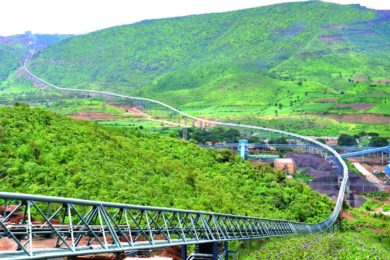A $13 million cooperative effort with America’s Office of Fossil Energy’s National Energy Technology Laboratory (NETL) over the past seven years has resulted in the successful demonstration of a novel technology that addresses a problem plaguing coal operators and environmentalists alike: separating fine coal particles from water and their ultimate use as a significant energy resource. Researchers at the Virginia Polytechnic Institute and State University (Virginia Tech) in Blacksburg have developed and patented an advanced technology called a hyperbaric centrifuge that can successfully remove water from very fine coal slurries. During recent prototype tests at Arch Coal’s Cardinal plant in Logan County, West Virginia, the technology reduced the moisture to a level that the waste coal can now be marketed commercially. The result is significant in that coal producers each year discard large amounts of moisture-laden coal fines that can potentially be salvaged for energy use while simultaneously cleaning up the environment.
“We are heartened by the success of Virginia Tech’s technology because it represents a major step forward in clean coal separation technology while addressing environmental concerns associated with waste coal impoundments,” said Dr. Victor K. Der, Principal Deputy Assistant Secretary for Fossil Energy. “The continued success and application of this technology holds promise for converting millions of tonness of ‘lost’ energy into a valuable resource for the US energy consumer.”
Virginia Tech received the award from NETL as part of the Office of Fossil Energy’s Hydrogen and Fuels program. Virginia Tech used the grant to develop the prototype centrifuge, evaluate its operation and design, and demonstrate it at coal-cleaning plants in Virginia, Alabama, and West Virginia. Several other technologies were also developed as part of the $13 million cooperative research effort.
Virginia Tech’s Center for Advanced Separation Technologies (CAST) tested the centrifuge at three operating plants, including the most recent test at the Arch Coal plant, where waste coal slurry went through the centrifuge at a rate of 30 gallons per minute and was dewatered to 13-19% moisture with coal recovery greater than 97%. Virginia Tech, in conjunction with West Virginia University, formed CAST in 2001 under the sponsorship of NETL to develop advanced separation technologies.
The prototype unit tested at the Cardinal plant was constructed by Decanter Machine as part of a license agreement with Virginia Tech. Based on the successful test result, the company is currently building a full-size commercial unit with a capacity of 600 gallons/minute. Virginia Tech holds a US patent on the technology, as well as international patents in seven countries.
Dr. Roe-Hoan Yoon, the lead developer of the technology at Virginia Tech, explains that the centrifuge applies a combination of air pressure and centrifugal force to successfully reduce significant levels of moisture in fine coal. He said that the idea came from basic research.
The success of the hyperbaric centrifuge is significant in the overall scheme of clean coal research in that the high moisture content of fine coal waste forces coal producers to discard the waste in storage areas called waste impoundments. Estimates indicate that these impoundments nationwide hold about 2,000 Mt of fine coal in abandoned ponds and an additional 500 to 800 Mt in active ponds. Technology that can recover these wastes would produce valuable resources to energy supplies.
Removing moisture from very fine coal particles left over from the coal preparation process has been difficult in the past. Conventional methods such as thermal dryers or mechanical dewatering have either been too costly or have been unable to dewater ultrafine coal particles (0.1 mm or less). The hyperbaric centrifuge has successfully addressed those issues.
Virginia Tech researchers explain that the centrifuge, when combined with another Virginia Tech-developed clean coal technology called Microcel, can remove both ash and water from the fine coal discarded at impoundments. These technologies will not only help coal producers minimise waste generation, but will also create small businesses recovering coal from existing waste impoundments.








